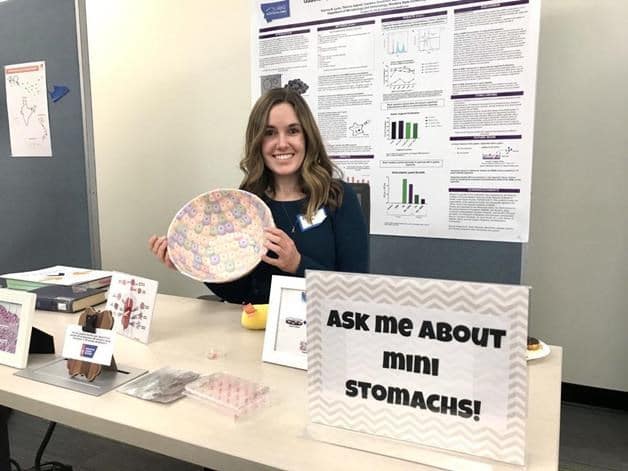
Katrina Lyon thought she might end up just cleaning test tubes when she signed up as an undergraduate to work in a scientific research lab at Montana State University.
Instead, she’s been working on real research to find out if black raspberries can help fight stomach cancer.
While two lines of experimentation haven’t shown benefit so far, Lyon said, a third did show promise that black raspberry extract can greatly reduce microbes that cause gastric cancer.
“It’s pretty great,” said Lyon, a 23-year-old senior from Illinois. Now, instead of her original goal of medical school, she wants to earn a Ph.D. so she can teach and keep doing research.
“I do love research,” she said Friday. “It’s inspiring. There’s a worldwide team of talented researchers working to end human suffering.”
Lyon is one of eight talented MSU undergraduates whose research work was showcased this past January at the Museum of the Rockies. MSU hosted its first “8×8 Student Innovation Road Show” on Jan. 30 at the Museum of the Rockies.
Each student spoke for eight minutes to explain their work and what they’re discovering. The event is patterned after MSU’s 10×10 Innovation Road Shows that feature faculty members talking about their research and creative projects.
MSU prides itself as a leader in getting undergraduates opportunities to learn, not just passively from textbooks and lectures, but actively though doing hands-on research.
The Bozeman campus is ramping up to host the 2020 National Conference on Undergraduate Research this spring. It is expected to bring 4,000 students and faculty mentors to MSU March 26 to 28 to share and promote undergraduate research.
Lyon never planned to try research, assuming it was only for super, A-plus students.
“I never saw myself in a lab coat,” she said. “I thought, ‘Oh no, they won’t want me.’”
But her adviser urged her to try, and she spotted a poster about professor Diane Bimczok’s research using “organoids,” three-dimensional cell cultures created in glass lab dishes to mimic human lungs, hearts or stomach tissue.
“I thought it was the coolest thing,” Lyon said. She emailed the professor asking for the chance to work in her lab and was accepted. For more than a year Lyon has been working with organoids to test the effects of berry extracts on pre-cancerous cells.
Lyon is so excited about it, she’ll sometimes go back to do more in the lab after working past midnight at Rosauers Supermarket, where she has a full-time job as a floor manager.
The difference between learning through research and textbooks, Lyon said, is that sometimes a student can be “book smart” but when they try research and lab results don’t turn out as expected, they feel they’ve failed.
“With research, you have to see it as ‘This didn’t work, but something else might,’” she said.
Also speaking at the museum event will be Lilianna Bento, 21, who grew up on a California dairy farm and is pursuing two degrees in crop science and sustainable food & bioenergy systems crop production.
Bento said she has been working to discover the source of herbicide contamination in organic grains. When glyphosate, the active ingredient in Roundup, turns up in organic crops, it’s a big problem because that crop can no longer be sold as organic at a premium price, she said.
The lab she’s working in has been trying to determine whether contamination comes from herbicide drifting from a neighboring farmer’s field, or from rain and snow, or happens during shipping. So far, Bento said, they’ve been able to rule out shipping.
Bento said she may want to go into the field of weed ecology and herbicide resistance after graduation. “It’s nice to have some research experience,” she said, “before you go out and find a job.”
Natalie Sturm will give her eight-minute talk about research at the Food and Health Lab. Sturm has been working on growing food that is so full of nutrients that it can improve people’s health. She has been growing spinach under different conditions to find differences in nutritional quality.
“Research has played an immensely powerful and positive role in my undergraduate education,” Sturm wrote in an email. It has given her real world context for what she learns in class and made her a better problem solver and thinker.
“Undergraduate research has given me more opportunities, both during my time at MSU and into the future,” she said, “than I ever could have imagined.”
Other students presenting at the museum event will be Keith Fuge, Brianna Bull Shows, Miles Maxcer, Brenden Pelkie and Rachel Dunlap.
By Gail Schontzler
Please visit https://www.bozemandailychronicle.com/research-opens-doors-for-msu-undergraduates/article_7cc8e79b-ff26-5c6b-be10-3c1d0fe167f4.html to view the original article.
Founded in 1978, the Council on Undergraduate Research (CUR) focuses on providing high-quality and collaborative undergraduate research, scholarly, and creative activity. Among the many activities and networking opportunities that CUR provides, the organization also offers support for the professional growth of faculty and administrators through expert-designed institutes, conferences, and a wide-range of volunteer positions. The CUR community, made up of nearly 700 institutions and 13,000 individuals, continues to provide a platform for discussion and other resources related to mentoring, connecting, and creating relationships centered around undergraduate research. CUR’s advocacy efforts are also a large portion of its work as they strive to strengthen support for undergraduate research. Its continued growth in connections with representatives, private foundations, government agencies, and campuses world-wide provides value to its members and gives voice to undergraduate research. CUR is committed to inclusivity and diversity in all of its activities and our community.
CUR focuses on giving a voice to undergraduate research with learning through doing. It provides connections to a multitude of campuses and government agencies, all while promoting networking and professional growth to its community.


